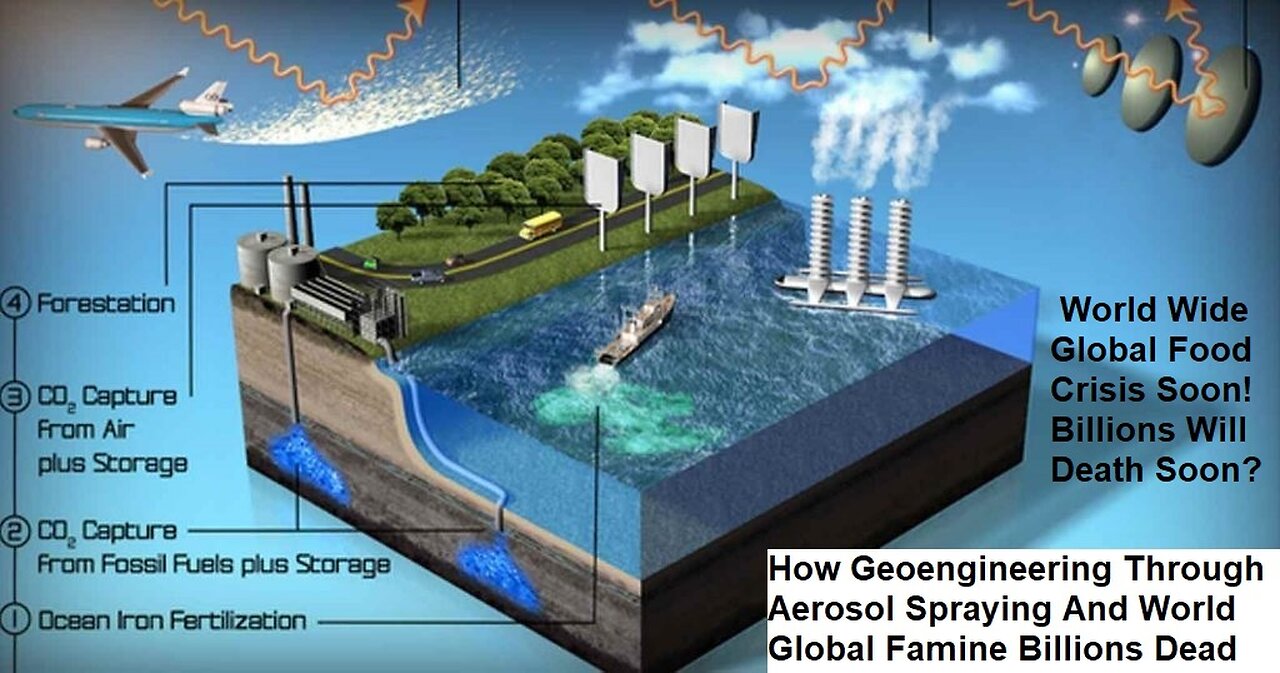Premium Only Content

Geoengineering Through Aerosol Spraying And World Global Famine Billions Dead
Bill And Melinda Gates Foundation Say How Can U.S.A. Kill Billions People With Covid-19 And World Wide Famine's – a note on famine in small farm societies is investing heavily in solar geoengineering research, which is meant to mimic the effects of a giant volcanic eruption by sending planes at high altitudes and spraying millions of tons of particles around the planet to create a massive chemical cloud that would cool the surface. The technology is not far from being ready and it’s affordable, but it could cause massive changes in regional weather patterns and eradicate blue sky.
Fires burning across the Amazon rainforest have renewed the debate about solutions to climate change. Bill Gates is backing the first high-altitude experiment of one radical approach called solar geoengineering. It's meant to mimic the effects of a giant volcanic eruption. Thousands of planes would fly at high altitudes, spraying billions of tons of particles around the planet to create a massive chemical cloud that would cool the surface.
"Modeling studies have found that it could reduce the intensity of heat waves, for instance, apparently it could reduce the rate of sea level rise. It could reduce the intensity of tropical storms," said Andy Parker, project director at the Solar Radiation Management Governance Initiative.
The technology is not far from being ready and it's affordable, but it could cause massive changes in regional weather patterns and eradicate blue sky.
"These consequences might be horrific. They might involve things like mass famine, mass flooding, drought of kinds that will affect very large populations," said Stephen Gardiner, author of "A Perfect Moral Storm: The Ethical Tragedy of Climate Change."
The quotation in my title comes from a brief online review of my book from someone who clearly wasn’t a fan. I suspect the person concerned didn’t actually read the book, but no matter. For my part, it seems to me quite likely that a billion people or more will die prematurely if we don’t soon implement something like the small farm future that I describe in the book. It’s worth sitting awhile with that contradiction. What an extraordinary moment in history when different people think that either persisting with or not persisting with the regnant political economy might slay us in such unimaginable numbers.
Maybe I’ll come back to that in another post. Here, I just want to make a few points about famine in societies of the past, present and future, building on the analysis from Chapter 10 of my book – famine being, along with its companions war, disease and poverty, among the likeliest contenders for causing the untimely deaths of billions.
So, one of the objections to the idea of an agrarian localist or a small farm future indeed is the notion that they’re prey to hunger or famine in ways that modern societies are not. The term ‘subsistence farmer’ hardly helps, routinely associated as it is with other words like ‘scratching’ or ‘bare’.
This conceals a more complex reality. As I document in my book, ‘subsistence’ farmers have generally been well capable of creating a thriving and diverse livelihood for themselves, and building in safeguards against poor seasons. Indeed, you can make a strong case that small-scale local farming systems are more resilient to famine than the present nexus of large-scale commercial farms and urbanism. Maybe you can make the contrary case too. But the scale of farm operation will make little difference to the famines that will arise in worst-case climate, socioeconomic and strategic scenarios of the future. I see a turn to low-impact, local, small-scale farming basically as our best option now for avoiding those worst-case scenarios, and probably our only option for dealing with their consequences should they occur.
Nevertheless, it’s historically true that small-scale ‘subsistence’ farmers sometimes pooled resources on a larger scale in order to even out the inherent uncertainties of farming, especially in environmentally challenging situations. It seems the Chacoan people of what’s now New Mexico did this from around 700-1200 AD, creating a centralized state that drew various communities into its orbit. The Chacoan state’s main function was redistributive in the face of livelihood uncertainties, and when it could no longer continue to underwrite its people’s welfare they went their separate ways.
Contrast this with Pierre Goubert’s analysis of the peasantry in 17th century France:
The majority of the poor in the countryside farmed only two or three acres, and tried to live off this land completely, which they were more or less able to do as long as the weather was kind and the harvests were good. But they were all forced to find money with which to pay the royal taxes (which went up sharply after 1635), as they had to be paid in coin, as well as to pay seigneurial and other dues. That is why they always had to take their eggs, young cocks, butter and cheese, and the best of the fruit and vegetables to market, or to the neighbouring big house….They could keep little for themselves except what was strictly necessary or unsaleable1
It’s worth bearing in mind that underlying reality when contemplating state formation in early modern Europe and the splendours of its royal courts.
Or consider this report from a citizen of the Dutch town of Limburg in 1790 where trade was limited and farming ‘almost medieval’: “One ate and drank what the farm provided. Because very little could be sold, the farmer had ample to eat”2.
And a final example, running counter to Monty Python’s famous historical thesis, and with some bearing on recent discussions here about the healthiness of animal products: research on ‘Dark Age’ Britain in the aftermath of Roman departure suggests that “an increase in animal protein (including the dairy products that were gained from a greater emphasis on pastoral husbandry) and a concomitant decrease in the proportion of carbohydrates in everyday diets appear to have led to general improvements in health across the board, visible in increases in average height, better dental health, and higher recovery rates from infection”, and hence “the beneficial effect on peasant household economies of the withdrawal of Roman secular and military administration”3.
So against redistributive states like the Chacoan, or the de facto self-reliance of Limburg, perhaps we can counterpose more hunger-prone scenarios fostered by large predatory states – the Romans in Britain and early modern states in Europe among them.
In reality, the distinction is perhaps overdrawn. There were hierarchical elements in the Chacoan state, and there were ubiquitous uprisings and complex social alignments in Europe and elsewhere against the predations of overmighty states that ensured a redistributive aspect. This latter point is important, and I’ll be pressing it in future – predatory states are sometimes willing to extract resources from ordinary people up to the point of rank starvation if they can get away with it, but what often stops them from doing so is the ability of ordinary people to organize politically and make themselves protagonists in the political drama of the state.
My examples so far have all been quite a way back in the past. What of present and recent times? Famine expert Alex de Waal calls the first part of the 20th century “the most dreadful period of famine in world history”4 when modern leaders of various political colours such as Adolf Hitler, Winston Churchill, Josef Stalin and (later) Mao Zedong either actively created famines or connived at them in pursuit of their wider political goals. It’s perhaps worth noting that communist leaders like Stalin and Mao particularly inflicted hunger on the peasant classes whose activism was substantially responsible for putting them into power, in pursuit of breakneck industrialization policies dictated by Marxist-Leninist doctrines alien to peasant communism. Such famines of 20th century ‘development’ came on the heels of 19th century famines of colonial capitalism in other parts of Asia and Latin America. So there are good grounds for questioning the notion that famines were banished by modernization.
But more recently the incidence of major famines has declined, leaving us only with the small matter of chronic under-nutrition among possibly billions of people in a world that’s richer in total and per capita terms than ever before. ‘Developed’ or ‘middle income’ countries like Russia and China that experienced major famines in recent times are unlikely to experience them again in the near term, whereas ‘less developed’ countries, especially in sub-Saharan Africa, are on shakier ground. This prompts a narrative that capitalist or industrial development is the vanquisher of famine, and that we need more of it to finally banish it from the global scene.
I think this narrative is mistaken. I also think it rests on a horrifically ends-justify-means view of history that implicitly shrugs off the deaths of past millions as an acceptable cost of modernization. For all that, I’m as happy as anyone to celebrate the decline of major famines in the present. But it’s important to note they’ve declined largely because of an international humanitarian politics that considers famines unacceptable.
In A Small Farm Future I argue that we need to retain that humanitarianism, but I’m not sure that we’ll be able to do so under the auspices of our existing system of nation-states. There are already plenty of signs that this system’s mask is slipping, revealing the beggar-my-neighbour or beggar-my-populace face of the predatory state behind it. And that, in a nutshell, is why I think people are well advised to generate their own subsistence, or, better, to generate local communities that enable them to do so. If we don’t get on top of climate change (another challenge to which the existing system of states appears unequal) perhaps major famines are likely anyway, but if we leave our subsistence in the hands of the existing system of states we may well experience black swan famine events all the sooner and all the more devastatingly.
Of course, if everyone upped sticks overnight and headed to the countryside in search of a more sustainable subsistence (or if some neo-Maoist state forced them to), we certainly would experience famines and various other ghastly outcomes in short order. So the challenge is to see the writing on the wall before it’s too late and move more rationally towards a sustainable agrarianism. Or, as I put it on p.207 of my book, to choose a small farm future voluntarily in the present so as to avoid having a worse one imposed by Maos of the future.
Since we often extol the foresight of business leaders in modern capitalist society, perhaps we might learn from the example of internet billionaire Peter Thiel, who seems to have realized that in the final analysis you can’t eat money and has bought up a large spread of remote New Zealand farmland to safeguard against future uncertainties. Few of us have the means to do that, but what we can do is start working in any number of different ways to try to build a convivial agrarianism within our local communities. It won’t be easy, but if we pull it off then maybe some of us will be able to look back with pride at how we helped avoid or maybe not avoid and help killing a billion people by famine.
Bill Gates boosts fight against virus that threatens three billion Microsoft billionaire Bill Gates has donated £27m (£16m; €22m) to step up the fight against a debilitating virus that kills one in three of its victims.
The Bill and Melinda Gates Foundation this week announced funding for a five year programme to combat Japanese encephalitis, the leading cause of viral encephalitis in Asia.
Almost half of all cases of the disease, a mosquito borne flavavirus, result in long term disability, including paralysis, seizures, and mental disability.
A third of victims, mainly children aged under 15, die. The condition isuntreatable but can be prevented through vaccination.
The Children's Vaccination Project at the Program for Appropriate Technology in Health (PATH), in Seattle, Washington, will use the money to accelerate development of an improved vaccine and bolster disease surveillance.
Project director Dr Julie Jacobson said it was "an absolute travesty" that so little had been done to protect people against a virus that now threatened up to three billion people in Asia.
Dr Jacobson said vaccine development had "languished on the back burner" because Japanese encephalitis was largely confined to the developing world.
"The vaccine used at the moment is expensive and in short supply. There is no economic incentive for manufacturers to develop it," said Dr Jacobson.
She said the disease was frequently mistaken for other diseases as diagnostic tests were not readily available so public surveillance had to be improved.
The centre will work with the Global Alliance for Vaccines and Immunisation to help countries incorporate the adopted vaccine into routine immunisation campaigns. It will also try to convince manufacturers there is a market for their vaccines in affected countries.
The current vaccine is derived from mouse brain and requires one mouse to produce each dose. Three doses are needed to gain 90% efficacy, and boosters are given every three years.
China produces and uses a live attenuated vaccine that is yet to be approved by the World Health Organization because of concerns about the manufacturing process. A recombinant vaccine using a strain of the yellow fever virus was successfully tested in animals and humans, but the manufacturers have yet to commit to production.
Some 30 000 to 50 000 cases of Japanese encephalitis are reported each year, resulting in 10 000 to 15 000 deaths.
The virus is prevalent in East Asia, South Asia, and South East Asia. Recent large outbreaks in India and Nepal have raised serious concerns that the disease is spreading more rapidly. It is most commonly spread by the Culex tritaeniorhynchus mosquito, which breeds in flooded rice fields, marshes and standing water pools. Pigs and wild birds are the main virus hosts.
Bill Gates predicts 16,900,000 victims from corona vaccination Click on the links below for the full story and or Type it into a Web Base Search !
https://www.exposingtheirlies.com/post/some-covid-19-horror-stories-you-may-have-missed
WHO’s DoV vision led to a collaboration in which Bill Gates’ GAVI serves on the leadership council. The Global Vaccine Action Plan (“GVAP”) – endorsed by the 194 Member States of the World Health Assembly.
The US billionaire Bill Gates is a big player in the corona crisis and in the vaccination business in general, finances the WHO vaccination program to a large extent and wants to vaccinate all 7 billion people against COVID-19, including those already cured. In an interview with CNBC, Gates says that for every 10,000 people, permanent vaccination damage would occur and he expects 700,000 victims.
Towards the end of the short CNBC interview Bill Gates (1) says:
„We have … you know … one in ten thousand … ah … side effects. Thats … you know … way more. Seven hundred thousand … ah … you know … people who will suffer from that. So, really understanding the safety at gigantic scale across all age ranges – you know – pregnant, male, female, undernourished and existing comorbidities. It’s very, very hard and that actual decision of ‚OK, let’s go and give this vaccine to the entire world‘… ah … governments will have to be involved because there will be some risk and indemnification needed before that … ah … can be decided on.“
He expects 700,000 victims. And he’s the one who is massively promoting this vaccination, whereby „promoting“ is extremely euphemistic. So one can speculate about even more victims. These numbers are much higher than the actual number of victims caused by the corona virus, whether dead by or with Corona or „other victims“. Regardless of whether one takes the increased numbers of the RKI or numbers represented by numerous experts (2). According to Gates, this would mean 8,300 corona vaccination victims for Germany with its 83 million inhabitants. He calls this – death or permanent disability – „side effects“.
The responsibility and costs of compensation (as if it were so easy to compensate) for the vaccination campaigns should be carried by the states. Bill Gates has obviously learned to protect himself better (3-8). The price for this is the naming of presumed numbers of victims, but multi-billionaire Gates is probably quite sure that he will not be blamed by the media and politicians.
COVID-19 Vaccines Will Kill You? Animation What Happens If You Get Coronavirus Effect - https://rumble.com/v2dt6zk-covid-19-vaccines-will-kill-you-animation-what-happens-if-you-get-coronavir.html - No question that the mRNA vaccines should be withdrawn with immediate effect” An independent analysis of the accumulated Yellow Card data, finally released 18 months after the first FOI request, shows unequivocal safety signals linking the mRNA vaccines to serious damage to the lymph system, the heart, and female reproduction 'Health regulator failing to keep public protected from mRNA shots' IN the UK, three Covid-19 vaccines - AstraZeneca (AZ), Pfizer (PF) and Moderna (MO) - have been used in a nationwide inoculation programmed aimed at preventing harm from the so-called SARS-CoV2 virus.
Expert Claims Covid Vaccines Will Kill 700 million People Around the World. During an interview with USA Watchdog in June, Dr. David Martin predicted that 700 million people will die worldwide due to the Covid injections. He based his estimation on the World Health Organization's vision of the ‘Decade of Vaccines’ (“DoV”).
Healthy Athletes Dropping Dead of Cardiac Arrest for No Reason A New Bioweapon ? - https://rumble.com/v2dvl62-healthy-athletes-dropping-dead-of-cardiac-arrest-for-no-reason-a-new-biowea.html - A New Bioweapon Globally As Of This Date 16 March 2023, there have been 760,360,956 confirmed cases of COVID-19, including 6,873,477 deaths, reported to WHO. As of 14 March 2023, a total of 13,232,904,667 vaccine doses have been administered. 6,033,218 Injured Recorded in Europe and USA Following COVID Vaccines with 4,358 Fetal Deaths in U.S. as of July 4 2022 -To date, the coronavirus disease 2023 (COVID-19) pandemic has taken more than 6.8 million lives. Many of these deaths have been attributed to misleading information that fragmented a coordinated effort to mitigate loss of life. Future pandemics will continue to be a threat, so it is important to lay bare the true cause of this devastation. From the beginning, the origins of the pandemic have been debated, even though a natural zoonotic transfer to humans has been determined as the likely cause; however, speculation around a viral bioweapon and laboratory leaks remains. The evidence for the origins of this current pandemic can be found in the science and history behind biological outbreaks and the signs of bioweapon use. This knowledge will help minimize the harm of future pandemics.
Sudden death in young people: Heart problems often blamed
Sudden death in young people is rare, but those at risk can take precautions. Find out more about the risk factors, causes and treatments. By Mayo Clinic Staff
Sudden cardiac death is the swift and unexpected ending of all heart activity. Breathing and blood flow stop right away. Within seconds, the person becomes unconscious and dies.
Sudden cardiac death isn't the same as sudden cardiac arrest (SCA). SCA is the sudden loss of heart activity due to an irregular heart rhythm. Survival is possible with fast, appropriate medical care.
Sudden cardiac death in seemingly healthy people under age 35 is rare. It's more common in males than in females.
When sudden death occurs in adolescents and young adults, it's sometimes due to undiagnosed heart conditions such as a genetic heart disease. The undetected heart problem may cause a young person to suddenly die during physical activity, such as playing competitive sports. However, sometimes sudden cardiac death can occur without exertion.
Most student athletes compete yearly without a heart incident. If you or your child is at risk of sudden cardiac death, ask your health care provider about precautions you can take.
How common is sudden cardiac death in young people?
Most sudden cardiac deaths are in older adults, particularly those with heart disease. Yet sudden cardiac arrest is the leading cause of death in young athletes. Estimates vary, but some reports suggest that about 1 in 50,000 to 1 in 80,000 young athletes die of sudden cardiac death each year.
What can cause sudden cardiac death in young people?
Sudden cardiac death is often caused by faulty electrical signaling in the heart. A very fast heartbeat causes the lower heart chambers (ventricles) to quiver uselessly instead of pumping blood. This irregular heart rhythm is called ventricular fibrillation.
Any condition that puts a strain on the heart or damages heart tissue can increase the risk of sudden death. Some conditions that can lead to sudden cardiac death in young people are:
Thickened heart muscle (hypertrophic cardiomyopathy). The most common cause of sudden cardiac death in young people is this genetic condition that causes the heart muscle to grow too thick. The thickening makes it hard for the heart to pump blood and can cause fast heartbeats.
Heart rhythm disorders. Long QT syndrome is a heart rhythm condition that can cause fast, chaotic heartbeats. It's linked to unexplained fainting and sudden death, especially in young people. Long QT syndrome may be present at birth (congenital long QT syndrome) or caused by an underlying medical condition or medication (acquired long QT syndrome).
Other heart rhythm disorders that can cause sudden cardiac death include Brugada syndrome and Wolfe-Parkinson-White syndrome.
Blunt chest injury. A hard hit to the chest that causes sudden cardiac death is called commotio cordis. Commotio cordis may occur in athletes who are hit hard in the chest by sports equipment or by another player. This condition doesn't damage the heart muscle. Instead, it changes the heart's electrical signaling. The blow to the chest can trigger ventricular fibrillation if it strikes at a specific time in the signaling cycle.
Heart structure problem present at birth (congenital heart defect). Some people are born with changes in the heart and blood vessels that can reduce blood flow and lead to sudden cardiac death.
How can parents, coaches and others know if a young person is at risk of sudden cardiac death?
Many times, sudden cardiac death occurs without warning. When warning signs occur, they may go unrecognized. Take note and ask if a health checkup is needed for anyone who has:
Unexplained fainting (syncope). Fainting that occurs during activity or exercise could mean that there's a heart problem.
Shortness of breath or chest pain. These symptoms could be a sign of a heart problem. But they can be caused by asthma, so it's important to get a thorough health evaluation.
Family history of sudden cardiac death. Having a family history of sudden cardiac death makes a person more likely to have the same type of heart event. If there's a family history of unexplained deaths, talk with a health care provider about screening options.
Can sudden death in young people be prevented?
Sometimes. If you're at high risk of sudden cardiac death, a health care provider will likely suggest that you avoid competitive sports.
Depending on the underlying condition, medication or surgery may be recommended to reduce the risk of sudden death. For example, a medical device called an implantable cardioverter-defibrillator (ICD) may be implanted in the chest to continuously monitor the heart's rhythm. If a life-threatening heart rhythm problem occurs, the ICD delivers electrical shocks to reset the heart.
Many athletic training centers have a device called an automated external defibrillator (AED) that is readily available to use. An AED is a portable device used to treat someone during cardiac arrest. An AED delivers shocks to reset the heart.
Who should be screened for sudden death risk factors?
There's debate in the medical community about screening young athletes in attempt to identify those at high risk of sudden death.
One Italian study found that mandatory heart evaluation of young people with an electrocardiogram (ECG or EKG) leads to lower rates of sudden cardiac death. But some worry this type of screening can lead to false-positive results — signs that there's a problem when there really isn't. Another worry is that screening would lead to overdiagnosis of conditions that may never cause any harm.
It's not clear that routine ECGs given before athletes are cleared to play competitive sports can prevent sudden cardiac death. However, such testing might help identify some who are at increased risk.
If you have a family history or risk factors for conditions that cause sudden cardiac death, screening is typically recommended.
The American Heart Association doesn't recommend sudden cardiac death screening for young people who are not athletes and who don't have heart disease symptoms.
Should young adults with a heart problem avoid or limit physical activity?
It depends. If you're at risk of sudden cardiac death, talk to your health care provider about physical activity. Whether you can safely participate in exercise or sports depends on your specific condition. For example, if you have a medical device implanted in your chest to detect and stop irregular heartbeats, you should avoid full-contact sports. A direct blow to the chest may move the device.
Your care provider can tell you which sports and types of exercise are safe for you or your child.
The controversial subject of climate engineering or weather modification – which was popularized, and oversimplified with the term “chemtrails” – is stepping from the shadows and into the light of public scrutiny. What was once a conspiracy theory is now the subject of congressional debate and peer-reviewed studies. This month, a new study published in Environmental Research Letters, normalizes geoengineering and planes spraying particulates into the atmosphere to curb global warming.
The study recommends that a fleet of 100 planes make 4,000 worldwide missions per year to “save the world from climate change.” The planes would be spraying sulphate particulates into the lower stratosphere—around 60,000 feet up—to shield the earth from the sun to keep down temperatures.
The study is not the subject of conspiracy theory websites and is in fact being reported in the mainstream media. As CBS News reports:
The researchers examined how practical and costly a hypothetical solar geoengineering project would be beginning 15 years from now. The aim would be to half the temperature increase caused by heat-trapping greenhouse gases.
This method would mimic what large volcanoes do. In 1991, Mount Pinatubo erupted in the Philippines. It was the second largest eruption of the 20th century, according to the United States Geological Survey (USGS).
In total, the eruption injected 20 million tons of sulfur dioxide aerosols into the stratosphere. USGS said the Earth’s lower atmosphere temperature dropped by approximately 1-degree Fahrenheit. The effect only lasted a couple of years because the sulfates eventually fell to Earth.
Although controversial, some think that trying to mimic the impacts of a volcano eruption is a viable way to control global warming. This proposed type of climate geoengineering is called stratospheric aerosol injection (SAI). Theoretically if done at scale — and sustained — the impact can be large. The 1-degree temperature drop which accompanied Mount Pinatubo’s eruption is equal to about half of the human-caused warming Earth has experienced since the Industrial Revolution began.
One of the study’s authors, Dr. Gernot Wagner boasted about the inexpensive nature of spraying chemicals into the air to cool the earth, noting that this geoengineering practice “… would be technically possible strictly from an engineering perspective. It would also be remarkably inexpensive, at an average of around $2 to 2.5 billion per year over the first 15 years.”
Oddly enough, this study echoes the remarks of then-CIA director John Brennan when he addressed the Council on Foreign Relations in 2016, detailing a similar process of spraying chemical particulates in the atmosphere to cool the planet.
At the meeting, John O. Brennan addressed instability and transnational threats to global security at a meeting with the Council on Foreign Relations. During his long-winded talk of threats to US interests and how the largely CIA-created ISIL threat is impacting the world, Brennan brought up the topic of geoengineering.
Another example is the array of technologies—often referred to collectively as geoengineering—that potentially could help reverse the warming effects of global climate change. One that has gained my personal attention is stratospheric aerosol injection, or SAI, a method of seeding the stratosphere with particles that can help reflect the sun’s heat, in much the same way that volcanic eruptions do.
Brennan went on to echo the calls from some scientists who have called for aerial spraying.
An SAI program could limit global temperature increases, reducing some risks associated with higher temperatures and providing the world economy additional time to transition from fossil fuels. The process is also relatively inexpensive—the National Research Council estimates that a fully deployed SAI program would cost about $10 billion yearly.
The extent at which Brennan talked about stratospheric aerosol injection shows that he and the CIA have likely been considering this for some time.
As promising as it may be, moving forward on SAI would raise a number of challenges for our government and for the international community. On the technical side, greenhouse gas emission reductions would still have to accompany SAI to address other climate change effects, such as ocean acidification, because SAI alone would not remove greenhouse gases from the atmosphere.
On the geopolitical side, the technology’s potential to alter weather patterns and benefit certain regions at the expense of others could trigger sharp opposition by some nations. Others might seize on SAI’s benefits and back away from their commitment to carbon dioxide reductions. And, as with other breakthrough technologies, global norms and standards are lacking to guide the deployment and implementation of SAI.
“Chemtrails” have long been the talk of conspiracy theories with massive amounts of disinformation being posted all over the internet including fake studies and photos. However, it has been proposed that unintentional geoengineering may already be taking place. As Derrick Broze points out, researchers with the National Oceanic and Atmospheric Administration (NOAA) are suggesting contrails from airplanes may be inadvertently geoengineering the skies.
Chuck Long is a researcher with the Cooperative Institute for Research in Environmental Sciences (CIRES) at the NOAA Earth System Research Laboratory at the University of Colorado in Boulder. At the recent American Geophysical Union Fall Meeting, Long and his team released their paper, “Evidence of Clear-Sky Daylight Whitening: Are we already conducting geoengineering?” The analysis found that vapor from airplanes may be altering the climate through accidental geoengineering.
It may be a very long time before we know what, if anything, is actually going on in our skies. However, when the CIA and the mainstream media begin talking about geoengineering, we should listen.
Please share this story with your friends and family who think it’s only conspiracy nuts who talk about spraying things into the sky.
The Watch The Water “documentary” is being passed around the net like a blunt at a Rastafarian dinner party.
Blunts are good. This ‘documentary’ is not good. In my opinion.
The principal player in this “documentary” is a Dr. Byron Ardis, who is a chiropractor and acupuncturist. This is a problem as the Doctor is touted as a medical doctor and practitioner, yet is not. So there is a presumed layer of ‘credentialism’ on this presentation from the start. The interview does not examine the education (not schooling) that Ardis undertook to be able to make these conclusions. There is no real background on any of the science behind any of the conclusions provided.
Propaganda! was my first impression of this video. The sound track, and the production values reinforced that idea. This movie was NOT made to simply present facts, or an opinion. It was made to SELL an opinion.
To what end? Why do they want to push this view? There is no science provided, just pointers to presumed social engineering and plays for emotionalism based on the viewers’ perspective on current events. In this, it would seem that this effort has been to target a specific demographic of people. Thus the tentative conclusion is that the producers of this video are working an agenda.
Yes, Remdesivir is a shit drug with a tainted history & not good results. Yes, the hospital protocols are killing people. This was known. The video sheds NO new light on any of this, but rather uses these as hooks for engagement with the rest of the material presented which is ALL about snakes & snake venom. All this material is based on assertions, not evidence, that Ardis makes as claims. He provides no evidence, but rather states his conclusions made with medical jargon laden descriptions, none of which are backed up, merely asserted as factual.
Mushrooms and venom of all kinds are two of THE MOST STUDIED biochemical compounds on the planet as they are also THE most reactive within human biochemistry. So it is natural that one may find either, or both, medicinal mushrooms, or venom, employed in almost ANY given medical procedure. There are quite actually THOUSANDS of medical treatments based on venom peptides. As far back as 2200 years ago, the Yellow Emperor’s Medicinal Compendium from China notes the effectiveness of dried venom from snakes as well as snails and sea creatures for medicinal use.
Pick almost ANY medical condition, research into the approaches by all of medicine practitioners going back in time, and you will run into Snakes. Yep, sure and certain. There is a snake down there somewhere. Ardis doesn’t bring any of this up. Maybe it is because, as a chiropractor, he is basically ignorant of medicinal history. Or maybe he wanted to present this information as though it was ALL targeted to covid. Maybe his goal is to push the idea that ALL the snake stuff was JUST for covid. Maybe he & the video want to use your lack of knowledge about how wide spread venom is within biochemical processes for developing medicines in order to slant the information to present a specific agenda. Maybe?
Maybe it is all clickbait at some level. Maybe the whole agenda behind the video is to warp the understanding of a particular segment of the population in order to further the policy agenda evident in covid. The Deep State does this you know. They deliberately pollute the information stream of the opposition in order to come back later to harvest confusion and sew doubt. It is a tactic in information wars.
It would be interesting to view a body language break-down of this video. There is disharmony being expressed between the words, and the face/gestures. This disharmony further degrades confidence in the presentation.
IMO this video is SO much a propaganda piece, that it begs the question of Who is trying to sell What to Whom and for What tactical reason?
One last point. Venom is highly reactive. This basically means that there are parts of all enzymes that will want to bond with elements (usually oxygen, but also chlorine and others) that will reduce its electrical potential. That is to say, make it more ‘relaxed’ and far less reactive. Thus the idea of dumping any venom, snake or other critter, into a water system is silly. Venom would encounter vast amounts of oxygen, chlorine and all the other chemicals currently polluting the planet. It would be very very unlikely that the venom would survive in a reactive state that would be able to injure your body. And, if the venom was made into a more water stable product, by that very process, it would no longer be reactive enough to cause harm.
Conflict, economic shocks, climate extremes and soaring fertilizer prices are combining to create a food crisis of unprecedented proportions. As many as 828 million people are unsure of where their next meal is coming from. We have a choice: act now to save lives and invest in solutions that secure food security, stability and peace for all, or see people around the world facing rising hunger.
The scale of the current global hunger and malnutrition crisis is enormous, with an expected 345.2 million people projected to be food insecure – more than double the number in 2020. This constitutes a staggering rise of 200 million people compared to pre-COVID-19 pandemic levels.
More than 900,000 people worldwide are fighting to survive in famine-like conditions. This is ten times more than five years ago, an alarmingly rapid increase. An immediate response is needed. The global community must not fail on its promise to end hunger and malnutrition by 2030.
WFP is facing multiple challenges – the number of acutely hungry people continues to increase at a pace that funding is unlikely to match, while the cost of delivering food assistance is at an all-time high because food and fuel prices have increased.
Unmet needs heighten the risk of hunger and malnutrition. Unless the necessary resources are made available, lost lives and the reversal of hard-earned development gains will be the price to pay.
But why is the world hungrier than ever?
This seismic hunger crisis has been caused by a deadly combination of factors.
Conflict is still the biggest driver of hunger, with 70 percent of the world's hungry people living in areas afflicted by war and violence. Events in Ukraine are further proof of how conflict feeds hunger – forcing people out of their homes, wiping out their sources of income and wrecking countries’ economies.
The climate crisis is one of the leading causes of the steep rise in global hunger. Climate shocks destroy lives, crops and livelihoods, and undermine people’s ability to feed themselves. Hunger will spiral out of control if the world fails to take immediate climate action.
Global fertilizer prices have climbed even faster than food prices, which remain at a ten-year high themselves. The effects of the war in Ukraine, including higher natural gas prices, have further disrupted global fertilizer production and exports – reducing supplies, raising prices and threatening to reduce harvests. High fertilizer prices could turn the current food affordability crisis into a food availability crisis, with production of maize, rice, soybean and wheat all falling in 2022.
Costs are also at an all-time high: WFP’s monthly operating costs are US$73.6 million above their 2019 average – a staggering 44 percent rise. The extra now spent on operating costs would have previously fed 4 million people for one month. In countries including Nigeria, South Sudan and Yemen, WFP is already faced with hard decisions, including cutting rations to be able to reach more people. This is tantamount to taking from the hungry to feed the starving.
From the Central American Dry Corridor and Haiti, through the Sahel, Central African Republic, South Sudan and then eastwards to the Horn of Africa, Syria, Yemen and all the way to Afghanistan, conflict and climate shocks are driving millions of people to the brink of starvation.
Last year, the world rallied extraordinary resources – a record-breaking US$14 billion for WFP alone – to tackle the unprecedented global food crisis. In countries like Somalia, which has been teetering on the brink of famine, the international community came together and managed to pull people back. But it is not sufficient to only keep people alive. We need to go further, and this can only be achieved by addressing the underlying causes of hunger.
The consequences of not investing in resilience activities will reverberate across borders. If communities are not empowered to withstand shocks and stresses, this could result in increased migration and possible destabilization and conflict. Recent history has shown us this: when WFP ran out of funds to feed Syrian refugees in 2015, they had no choice but to leave the camps and seek help elsewhere, causing one of the greatest refugee crises in recent European history.
WFP’s changing lives work helps to build human capital, support governments in strengthening social protection programmes, stabilize communities in particularly precarious places, and help them to better survive sudden shocks without losing all their assets.
In just four years of the Sahel Resilience Scale-up, WFP and local communities turned 158,000 hectares of barren fields in the Sahel region of five African countries into farm and grazing land. Over 2.5 million people benefited from integrated activities. Evidence shows that people are better equipped to withstand seasonal shocks and have improved access to vital natural resources like land they can work. Families and their homes, belongings and fields are better protected against climate hazards. Support serves as a buffer to instability by bringing people together, creating social safety nets, keeping lands productive and offering job opportunities – all of which help to break the cycle of hunger.
As a further example, WFP’s flagship microinsurance programme – the R4 Rural Resilience initiative – protects around 360,000 farming and pastoralist families from climate hazards that threaten crops and livelihoods in 14 countries including Bangladesh, El Salvador, Ethiopia, Fiji, Guatemala, Kenya, Madagascar and Zimbabwe.
At the same time, WFP is working with governments in 83 countries to boost or build national safety nets and nutrition-sensitive social protection, allowing us to reach more people than we can with emergency food assistance.
Humanitarian assistance alone is not enough though. A coordinated effort across governments, financial institutions, the private sector and partners is the only way to mitigate an even more severe crisis in 2023. Good governance is a golden thread that holds society together, allowing human capital to grow, economies to develop and people to thrive.
The world also needs deeper political engagement to reach zero hunger. Only political will can end conflict in places like Yemen, Ethiopia and South Sudan, and without a firm political commitment to contain global warming as stipulated in the Paris Agreement, the main drivers of hunger will continue unabated.
Stratospheric Aerosol Injection (SAI) is a theoretical solar geoengineering proposal to spray large quantities of tiny reflective particles into the stratosphere, an upper layer of the Earth’s atmosphere, in order to cool the planet by reflecting sunlight back into space. Proposals range from spraying reflective particles, such as sulphur dioxides, finely powdered salt or calcium carbonate, from aircraft, shooting particles from artillery guns, or using large hoses to reach the sky. None of those solar geoengineering approaches address the underlying causes of climate change. In stead they aim to control the amount of incoming solar radiation by emulating the sulphur-rich dust cloud that remains in the atmosphere after large volcanic eruptions. In contrast to a volcanic outburst, SAI assumes continuous maintenance of the particle layers by regular injections.SAI using sulphur dioxide is the most-studied option. Computer simulations suggest that this technique would likely cause droughts in Africa and Asia and estimate that the SAI could endanger the source of food and water for two billion people.Because of the unequal global impacts and its potential to be weaponized, solar geoengineering carries insurmountable challenges for governance. Therefore, several hundred civil society organizations from around the world are calling for a multilateral ban on solar geoengineering.
NO LONGER CONSPIRACY CIA ADMITS PLANS OF AEROSOL SPRAYING FOR GEOENGINEERING Last week, the Director of the Central Intelligence Agency, John O. Brennan addressed instability and transnational threats to global security at a meeting with the Council on Foreign Relations. During his long-winded talk of threats to US interests and how the largely CIA-created ISIL threat is impacting the world, Brennan brought up the topic of geoengineering.
Another example is the array of technologies—often referred to collectively as geoengineering—that potentially could help reverse the warming effects of global climate change. One that has gained my personal attention is stratospheric aerosol injection, or SAI, a method of seeding the stratosphere with particles that can help reflect the sun’s heat, in much the same way that volcanic eruptions do.
Brennan went on to echo the calls from some scientists who have called for aerial spraying.
An SAI program could limit global temperature increases, reducing some risks associated with higher temperatures and providing the world economy additional time to transition from fossil fuels. The process is also relatively inexpensive—the National Research Council estimates that a fully deployed SAI program would cost about $10 billion yearly.
The extent at which Brennan talked about stratospheric aerosol injection shows that he and the CIA have likely been considering this for some time.
As promising as it may be, moving forward on SAI would raise a number of challenges for our government and for the international community. On the technical side, greenhouse gas emission reductions would still have to accompany SAI to address other climate change effects, such as ocean acidification, because SAI alone would not remove greenhouse gases from the atmosphere.
On the geopolitical side, the technology’s potential to alter weather patterns and benefit certain regions at the expense of others could trigger sharp opposition by some nations. Others might seize on SAI’s benefits and back away from their commitment to carbon dioxide reductions. And, as with other breakthrough technologies, global norms and standards are lacking to guide the deployment and implementation of SAI.
“Chemtrails” have long been the talk of conspiracy theories with massive amounts of disinformation being posted all over the internet including fake studies and photos. However, several real studies show that some ‘seeding’ or geoengineering may be taking place.
A study published in the International Journal of Environmental Research and Public Health is suggesting that geoengineering has already begun, and the substance being used is a toxic by-product of coal burning call coal-fly ash.
“The widespread, intentional and increasingly frequent chemical emplacement in the troposphere has gone unidentified and unremarked in the scientific literature for years. The author presents evidence that toxic coal combustion fly ash is the most likely aerosolized particulate sprayed by tanker-jets for geoengineering, weather-modification and climate-modification purposes and describes some of the multifold consequences on public health.
Also, it has been proposed that unintentional geoengineering may already be taking place as well. As Derrick Broze points out, researchers with the National Oceanic and Atmospheric Administration (NOAA) are suggesting contrails from airplanes may be inadvertently geoengineering the skies.
Chuck Long is a researcher with the Cooperative Institute for Research in Environmental Sciences (CIRES) at the NOAA Earth System Research Laboratory at the University of Colorado in Boulder. At the recent American Geophysical Union Fall Meeting, Long and his team released their paper, “Evidence of Clear-Sky Daylight Whitening: Are we already conducting geoengineering?” The analysis found that vapor from airplanes may be altering the climate through accidental geoengineering.
It may be a very long time before we know what, if anything, is actually going on in our skies. However, when the CIA, who is responsible for so much turmoil on a global scale, begins talking about geoengineering, we should listen.
Please share this story with your friends and family who think it’s only conspiracy nuts who talk about spraying things into the sky.
Geoengineering the atmosphere has been touted by climate scientists as a means to reduce global warming and mitigate its various impacts. They point to dangerous methane releases in the Arctic, melting glaciers, ocean acidification and extreme weather to justify using big jets to spray reactive chemicals into the sky. However, Antarctica's ice cap is growing, and the phenomenon of global warming has itself been challenged by those alleging ulterior motives lay behind it. Regardless, a handful of the country's top universities, including Harvard, Stanford and Carnegie Mellon, along with The Royal Society in the U.K., are leading lights in what appears at first glance to be a noble undertaking. By dispersing reflective particles into the atmosphere, and doing it daily for the forseeable future, global temperatures will cool as sunlight gets bounced back into space.
-
 51:32
51:32
What If Everything You Were Taught Was A Lie?
2 days agoThe History Of American Vehicles Automobile Age Is Melding Into A New Age Of Electronics Testla
1.37K1 -
 16:43
16:43
GritsGG
14 hours agoThey Buffed This AR & It Slaps! Warzone Loadout!
3.49K -
 2:05:30
2:05:30
Side Scrollers Podcast
18 hours agoEveryone Hates MrBeast + FBI Spends $140k on Pokemon + All Todays News | Side Scrollers Live
96.5K8 -
 11:06
11:06
The Pascal Show
12 hours ago $0.46 earned'THEY'RE GETTING DEATH THREATS!' Jake Haro's Lawyer Breaks Silence On Emmanuel Haro's Disappearance!
4.67K -
 LIVE
LIVE
Lofi Girl
2 years agoSynthwave Radio 🌌 - beats to chill/game to
408 watching -
 2:19:32
2:19:32
Badlands Media
1 day agoDEFCON ZERO Ep. 005: False Flags, Cyber Fronts & Global Power Plays
140K57 -
 2:35:23
2:35:23
FreshandFit
7 hours agoWhy Black Men Don't Date Black Women Debate
32.5K32 -
 2:03:42
2:03:42
Inverted World Live
11 hours agoBigfoot Corpse Coming to the NY State Fair | Ep. 94
104K24 -
 6:16:23
6:16:23
SpartakusLIVE
12 hours ago$1,000 Pistol Challenge || #1 ENTERTAINER of The EONS Eradicates BOREDOM
80.3K2 -
 2:33:37
2:33:37
TimcastIRL
9 hours agoTrump Orders Review of Smithsonian For Being Woke & Out of Control | Timcast IRL
182K74